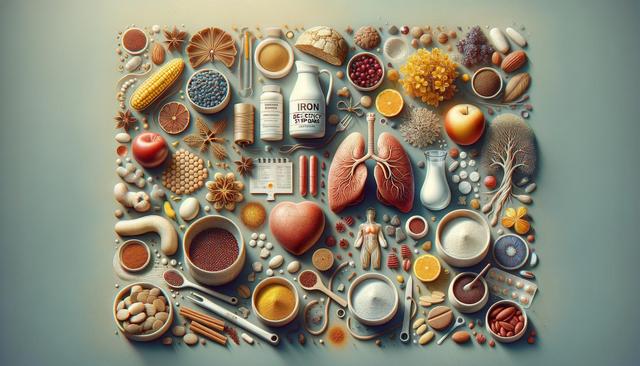Recognizing the Signs of Iron Deficiency
Iron lack can make you feel weak, tired, and pale. You may also have fast heartbeats, chills, or a sore tongue. Eating food rich in iron and seeing a doc can help you get back your strength and feel well again.

Understanding Iron’s Role in the Body
Iron is a critical mineral responsible for many essential functions in the body, particularly the production of hemoglobin—the protein in red blood cells that carries oxygen. When iron levels fall too low, the body cannot produce enough healthy red blood cells, leading to a condition known as iron deficiency anemia. This can affect your energy levels, cognitive function, and even your immune system. Iron is also involved in muscle metabolism and maintaining healthy connective tissue, making it vital for overall well-being.
People at greater risk of iron deficiency include:
- Women with heavy menstrual cycles
- Pregnant individuals
- Infants and young children
- Vegetarians or those with limited red meat intake
- People with digestive conditions that affect nutrient absorption
Recognizing iron’s importance can help you understand why even mild deficiencies should not be ignored. Addressing the problem early can prevent more serious health issues down the line.
Common Physical Symptoms of Iron Deficiency
Iron deficiency often presents through a range of physical symptoms that can gradually worsen if left untreated. The most noticeable signs are related to the body’s reduced ability to transport oxygen, resulting in fatigue and weakness. These symptoms may be subtle at first and mistaken for general tiredness or stress.
Common physical symptoms include:
- Pale skin or pale inner eyelids
- Shortness of breath during simple activities
- Dizziness or lightheadedness
- Cold hands and feet
- Fast or irregular heartbeat
In more advanced cases, individuals may experience chest pain or a feeling of tightness, especially when exerting themselves. These symptoms indicate that the body is working harder to pump oxygen, which it cannot do efficiently due to the low iron levels.
Unusual or Less Known Signs
In addition to the more obvious signs, iron deficiency can cause less familiar symptoms that may not immediately be associated with low iron. These can include cravings for non-nutritive substances, known as pica, where individuals may feel compelled to eat ice, dirt, or chalk. Though not fully understood, this symptom is often linked to severe iron deficiency.
Other less noticeable but important symptoms include:
- Restless leg syndrome—an uncontrollable urge to move the legs, especially at night
- Hair thinning or hair loss
- Brittle or spoon-shaped nails
- Swelling or soreness of the tongue (glossitis)
- Frequent headaches or difficulty concentrating
These symptoms can be disruptive and may affect quality of life. If you experience several of these signs together, it’s worth discussing them with a healthcare provider to explore the possibility of iron deficiency.
Diagnosing Iron Deficiency
Identifying iron deficiency requires more than just recognizing the symptoms. A proper diagnosis involves a combination of physical examination, discussion of dietary habits, and laboratory testing. Blood tests can determine overall hemoglobin levels, serum ferritin (which reflects stored iron), and transferrin saturation.
Your doctor may also ask about:
- Recent illnesses or bleeding episodes
- Menstrual history for women
- Dietary patterns and any recent changes
- Use of medications that may affect iron absorption or cause bleeding
In some cases, further tests may be needed to rule out underlying causes, such as gastrointestinal bleeding or malabsorption issues. An accurate diagnosis is essential for determining the appropriate treatment plan, whether through dietary changes, iron supplements, or addressing the root cause of the deficiency.
Steps Toward Recovery and Prevention
Treating iron deficiency effectively involves replenishing iron stores and maintaining healthy levels over time. This can often be achieved through a combination of diet and supplementation. Foods rich in iron include red meat, poultry, fish, lentils, beans, tofu, and iron-fortified cereals. Pairing iron-rich foods with vitamin C sources—like citrus fruits or bell peppers—can enhance absorption.
Preventive and recovery strategies include:
- Eating a balanced diet with sufficient iron sources
- Taking iron supplements if prescribed, and following dosage instructions carefully
- Avoiding excessive intake of calcium or antacids near iron-rich meals, as they can inhibit absorption
- Regular monitoring through blood tests, especially if you’re at higher risk
Recovery timelines vary depending on the severity of the deficiency and how well the body absorbs iron. Some individuals may begin to feel better within weeks, while others may require months of consistent treatment. Preventing recurrence involves ongoing attention to diet and health conditions that may affect iron levels.
Conclusion: Paying Attention to Your Body’s Signals
Iron deficiency is a common but often overlooked health issue that can significantly impact daily life. By staying alert to the physical and less familiar symptoms, individuals can take proactive steps to seek diagnosis and treatment. If you recognize signs like fatigue, pale skin, or unusual cravings, it may be time to evaluate your iron status. Consulting with a healthcare provider and making thoughtful dietary choices can support better energy, improved mood, and overall well-being.